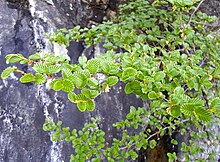Nothofagus gunnii
| Fuscospora gunnii | |
|---|---|

| |
| Scientific classification | |
| Kingdom: | |
| (unranked): | |
| (unranked): | |
| (unranked): | |
| Order: | |
| Family: | |
| Genus: | |
| Species: | F. gunnii
|
| Binomial name | |
| Fuscospora gunnii (Hook.f.) Heenan & Smissen
| |
| Synonyms | |
Fuscospora gunnii, the tanglefoot- or deciduous beech, or fagus, is a deciduous shrub endemic to the highlands of Tasmania, Australia. It grows in alpine and sub-alpine regions in the west to central portions of the state but is absent from the mountains of the northeast. Though capable of reaching a small tree, it rarely exceeds 2 m in height, instead growing as a thick shrub or as a woody ground cover hence the common name "tanglefoot".
Taxonomy
Joseph Dalton Hooker described the tanglefoot beech.
Common names include tanglefoot- or deciduous beech, or fagus,[1] which can also refer to the entire Beech family.
It was known as Nothofagus gunnii until 2013.[2] The change in name is controversial, and it is not necessary to accept this change.[3]
Description
The leaves are simple and alternate, growing 1 cm long. The leaf color is bright green, turning yellow, then brilliant red, in autumn. They are almost circular in shape with deep veins which end in the gaps between the rounded teeth on the leaf. The plant has separate male and female flowers on the tree. Both male and female flowers are small and inconspicuous. The fruit is small (about 6 mm wide) and woody, and contains three small winged nuts. In most years seed production is poor, but once in a while a 'mast' crop occurs with high germination. The seeds have a very short viability.
Tanglefoot forests cannot survive fire, and must re-establish from neighbouring areas. They are very sensitive to changed conditions due to their slow growth. Under 100 km² of forest remain.[1]
It is the only deciduous tree in Tasmania, and the only cold climate winter-deciduous tree in Australia.[1][4]
Cultivation
F. gunnii is difficult to cultivate, requiring around 1,800 mm of rain spread throughout the year, cool temperatures not below -10 °C and requires full sun. It grows in deep peaty soils. It is best grown from fresh seed collected in a 'mast' year, germinating in a few weeks. It is believed that a beneficial mycorrhyzal fungus is required for the long term success of the plant. Cuttings can be struck, taken in late winter before bud burst.
F. gunnii is rarely seen in cultivation due to its poor performance and slow growth. It is believed to be an excellent plant for bonsai, if it can be kept alive long enough.
References
- ^ a b c "Deciduous beech, or Fagus, Nothofagus gunnii". parks.tas.gov.au. Department of Parks & Wildlife, Tasmania. Retrieved 2 May 2015.
- ^ HEENAN, PETER B.; SMISSEN, ROB D. (2013). "Revised circumscription of Nothofagus and recognition of the segregate genera Fuscospora, Lophozonia, and Trisyngyne (Nothofagaceae)". Phytotaxa. 146 (1): 131. doi:10.11646/phytotaxa.146.1.1. Retrieved 31 May 2015.
- ^ Hill, R.S.; Jordan, G.J.; Macphail, M.K. 2015: Why we should retain ''Nothofagus sensu lato''. ''Australian systematic botany'', '''28'''(3): 190-193. doi|10.1071/SB15026
- ^ "Fagus Nothofagus gunnii". Parks & Wildlife Service, Tasmania. October 2010. Retrieved 2016-03-08.
